
Vol. XVIII, No. 3, April 2018
- Editor's corner
- Follow tomorrow's food culture trends or be in peril
- Which generation spends the most on F&B away from home?
- Doc Brundy's nearing completion
- Skate to where the puck is going to be
- Who uses social media?
- Pinball renaissance
- Table 47 & Ocean5 now open
- Move over cows, here come the plants
- Update on the Tchotchke Index
Move over cows, here come the plants

One of the fastest evolving macro food trends that is following after the almost now ubiquitous clean food trend (see our article ‘Clean food' is the new norm), is both plant-forward menu items that include plant proteins totally taking the place of meat and/or meat proteins being consumed in reduced amounts. Yes, we are seeing a fast-emerging trend that will make the Chick fil-A billboard cows very happy, as plant proteins are fast replacing beef as well as all other types of animal proteins.
Unlike a lot of food trends that are based on particular foods, flavor profiles or other menu specific attributes, plant-forward is the result of other social trends including sustainability, animal welfare and health.
Baum+Whiteman, international food and restaurant consultants, have proclaimed “Plant-based foods go mainstream” as the 2018 food trend of the year. Although only 6% to 7% of Americans are full-time vegetarians and less than 3% identify as vegans, more and more consumers are replacing meat with plants. First rate, good tasting vegetarian dishes are now available not only in restaurants, but also in supermarkets. It's no longer deprivation to go plant-forward and vegetarian.
Here are some research findings about American consumers to back up that claim:
- 47% have changed their diets in the last three years and are now eating healthier foods1
- 29% are actively trying to incorporate more plant-based foods in their diets2
- 31% practice meat-free days3
- 35% get most of their protein from sources other than red meat3
- 34% eat a totally vegan meal at least once a week4
- 51% are interested in eating meat blended with grains and veggies4
- 36% are buying plant-based proteins3
- 46% agree plant-based proteins are better for you than animal-based options3
- 22% limit meat and/or poultry, but don't exclude it entirely4
- Two-thirds (66%) of people who eat protein alternatives believe such products are healthier than meat3
- In 2012, 47% of consumers identified as regular red meat eaters. In 2017 it fell to 26% while the number saying they only occasionally eat red meat rose from 18% in 2012 to 52% in 20175
In a sense, plant-based has become the new organic.


Roughly one-third of Americans are now practicing flexitarianism. Flexitarians can be defined in two ways. First people trying to eat less beef, chicken, pork and dairy (sometimes referred to as reducetarianism). Second people already eating “mostly vegetarian,” with the occasional consumption of meat and dairy. Flexitarians are consuming more plants and less meat, just not totally eliminating meat from their diets. Flexitarians, combined with vegetarians and vegans, make up a little less than half of all consumers. That's a significant part of the dining public.
Americans love their hamburgers. It is America's most-ordered menu item. The average consumer eats a burger 5.3 times in a month, a higher average than for pizza - America's other favorite food - which the average consumer eats 3.4 times a month. Technomic reports that over one-sixth (17.5%) of all food service sales in 2016 was for burgers. That represented 44% of all sandwich sales.
Plant-forward and meatless is now becoming part of burgerland. The James Beard Foundation started their Blended Burger Project in 2015 to promote making better burgers by blending ground meat with chopped mushrooms, thus reducing the consumption of meat. They sponsor an annual contest to find the best blended burgers chefs around the country could create. You can check out the recipes for 2017 winners by clicking here.
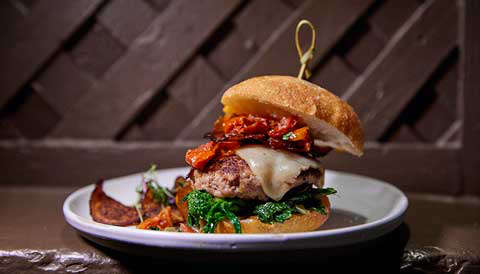 |
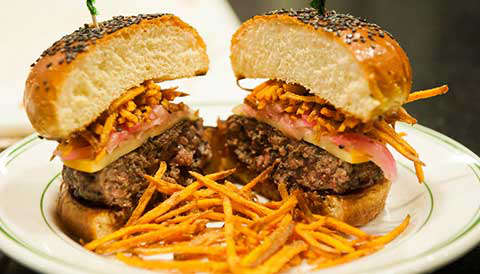 |
| 2017 JBF winning Porchetta Burger blended burger from the Bareburger restaurant, NYC (photo: David Chow). |
2017 JBF winning campus blended burger, the Lodi Dodi Smoke Burger at St. Norbert College, De Pere, WI. |

Blended burgers offer Flexitarians, people just looking for healthier burgers or people wanting to have a more sustainable choice a great option. Blended burgers are going mainstream. Sonic Drive-In, a 3,500 fast food restaurant chain, now features the Slinger on their menu, their take on a blended burger.
The meatless 100% plant-based burger, often referred as the veggie burger, is also making some fast inroads into American's restaurant dining options. But unlike earlier versions, the new recipes taste great! In fact, most people can't distinguish them from their meat cousins. All types of restaurants from fine dining to fast foods are starting to offer them, including such chains as The Cheesecake Factory, White Castle, Denny's, Johnny Rockets, TGI Fridays, Shake Shack and Red Robin. In fact, White Castle offers two different vegan burgers on vegan buns.
Two national suppliers are now offering their plant-based burgers to consumers in supermarkets and to restaurateurs. Beyond Meat has the Beyond Burger that is pink in the middle and actually bleeds red like real meat. Impossible Foods is offering their comparable Impossible Burger.
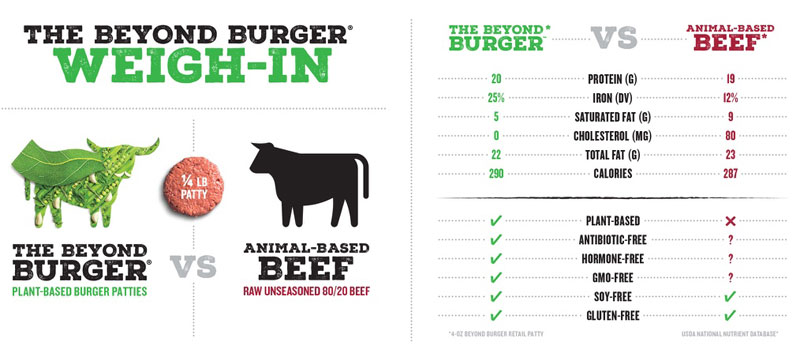
Beyond Meat says that 70% of consumers who buy its plant-based burgers are not vegetarians but rather are Flexitarians who are trying to cut back on their meat consumption.
Surprisingly, the number one reason that consumer eat plant-based proteins is because of their taste. Yes, vegetarian options have made quantum leaps in their appealing flavors.
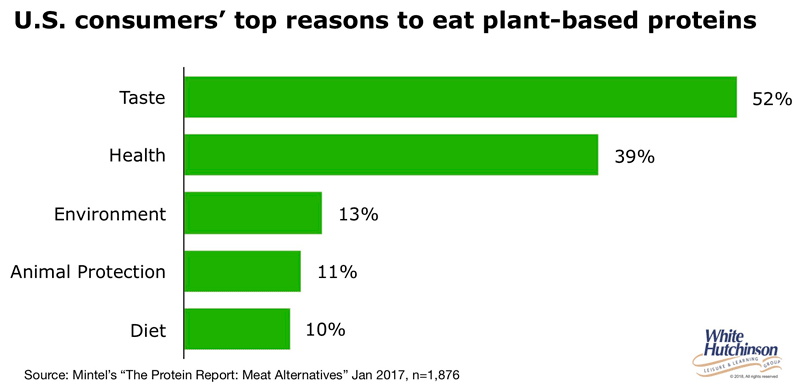

Panera's Vegan Lentil Quinoa Broth Bowl
Another plant-based protein alternative to meat that is growing in popularity is the grain bowl, a whole-grain base with raw and cooked veggies and maybe some nuts and seeds among other plant-based ingredients. You can now find them at a wide variety of restaurants. Panera Bread now offers a Vegan Lentil Quinoa Broth Bowl with organic quinoa and brown rice, lentil blend, tomato sofrito, fresh kale and spinach with a lemon wheel in an umami soy-miso broth.
Veggie restaurants are now a fast-growing restaurant segment. By Chleo, a 10-unit vegan fast-casual restaurant chain in New York City, just raised $31 million from several capital funds to fuel expansion. Veggie Grill, a West Coast based-chain with around 30 units, is expanding nationwide and just opened two locations in Chicago. Other vegetarian restaurants including Amy's Drive-Thru and Plant Power Fast Food are ramping up expansion plans.

Another significant trend with the consumer-driven plant-forward movement at sit-down table service restaurants is a reduction in the size of the meat portion in an entrée and an increase in the vegetable portion of the entrée. We're even seeing a reduced meat portion option showing up in contemporary takes on steakhouse restaurants, notoriously known for large meat portions to satisfy hungry carnivores. GT Prime in Chicago has reinvented the steakhouse restaurant. Although they do offer those traditional large portions of meat, you can also order just 4- or 8-ounce portions. These work great as sharables, as a group can order a number of different meat selections, such as bison tenderloin, lamb, venison, beef strip in 4-ounce or 8-ounce petite portions and share. What's great is the portions come cooked to order already sliced for sharing.
The animal-based food reduction trend is not limited to just meat. It includes such things as vegan ice cream. Both Ben & Jerry's and Haagen-Dazs now offer a selection of non-dairy vegan ice creams.

Even Starbucks now offers almond, coconut and soymilk alternatives and vegetarian and certified vegan lunch options. This year they will be introducing a plant-based formulation of their iconic bottle Frappuccinos. We're even starting to see vegan cocktails at bars.
Based on our extensive research on food culture, the plant-forward macro trend was something our company identified before it took off. We introduced it into our clients' menu offerings when we were first developing their menus, so they would be on trend when they opened a year or two later. The menus we are developing for our clients, working with our Alliance executive chefs, now feature approximately 30% meatless, great tasting and craveable plant-based menu options. But we don't forget the carnivores, as you still need to have good options for them. So, we do have meat options. When it comes to hamburgers, at one of our client's CLVs the menu will offer the options of a bison burger, a grass-fed beef blended burger and a veggie burger similar to the Beyond Burger. We are also using jackfruit to develop vegetarian sandwich and slider options.
Our project in the South Puget Sound, the Table 47 restaurant, located in Ocean5, has finally opened. We've been working with its owner, Troy Alstead, the former COO of Starbucks, for over 10 years. Yes, the project took 10 years from conception to its opening April 8th. Table 47 features a wide selection of vegetarian and plant-forward menu selections, such as Butternut Squash Gnocchi, three different vegetarian flatbreads including Olive & Sunchoke and Pear & Walnut, Moroccan Vegetables and a BBQ Jackfruit Sandwich. Table 47 is a cutting edge restaurant that also incorporates a number of other fast growing restaurant trends that we identified a number of years ago when it was being designed and the food production and menu was being developed, including menu items available in both entrée size and small plate sharable sizes, an exhibition kitchen, farm-to-table and local sourcing, scratch kitchen, sustainable building and operation practices including geothermal heating and cooling, a vermiculture composting worm farm for paper towel and pre-production plant matter food waste, wine on tap from kegs and micro greens grown in-house. We'll have more about Table 47 and Ocean5 in our next issue.
Another one of our projects, Doc Brundy's in Spanish Fork, Utah, is anticipated to open in June and will have a menu that also has a wide selection of vegetarian and plant-forward items. Two vegetarian menu items from the tasting we held early this year with our client are shown below.
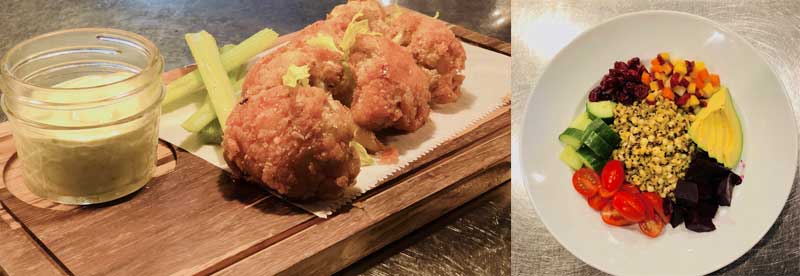
Buffalo Cauliflower; Fried Quinoa Protein Bowl
Implications for CLVs
Great contemporary food and drink options are now essential to success at CLVs, no matter what size and type. Plant-forward and vegetarian options are only one of the many fast evolving food trends that need to be incorporated into the CLV menu offerings.
Sources
- James Beard Foundation
- Nielsen
- Mintel
- Datassentials
- Crimson Hexagon
Vol. XVIII, No. 3, April 2018
- Editor's corner
- Follow tomorrow's food culture trends or be in peril
- Which generation spends the most on F&B away from home?
- Doc Brundy's nearing completion
- Skate to where the puck is going to be
- Who uses social media?
- Pinball renaissance
- Table 47 & Ocean5 now open
- Move over cows, here come the plants
- Update on the Tchotchke Index



